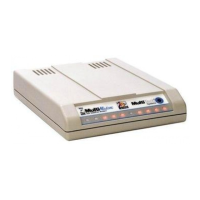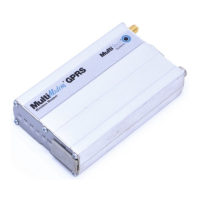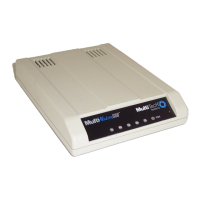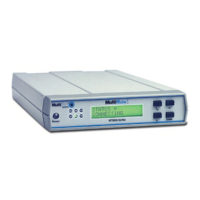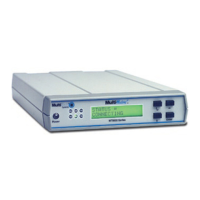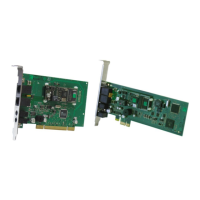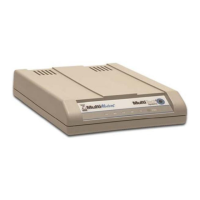Do you have a question about the Multitech MultiConnect Cell MTC-LVW2 and is the answer not in the manual?
Provides an overview of the MultiConnect Cell 100 Series MTC-LVW2 cellular modems.
Lists the available documentation for the MultiConnect Cell 100 Series, including AT Commands Reference Guide.
Details the physical dimensions and layout of the MultiConnect Cell modem.
Provides information specific to the serial interface of the device.
Details the physical dimensions and layout for the serial version with GPS.
Explains the function of the Power, TR, CD, LS, and PROG. SIGNAL LEDs on the device.
Shows the location and type of connectors on the side panels of the device.
Lists the technical specifications for the MTC-LVW2 model, covering general, speed, interface, and connectors.
Details the pinout and function of the RS-232 9-pin female connector.
Provides power draw measurements for different operating modes and voltages.
Details power consumption measurements for the serial model MTC-LVW2-B01.
Details power consumption measurements for the serial model with GPS MTC-LVW2-B02.
Advises on safety precautions related to radio frequency interference and usage.
Discusses potential interference between cellular devices and medical equipment like pacemakers.
Offers specific precautions for individuals with pacemakers to avoid potential interference.
Addresses antenna compliance with FCC rules and RF exposure requirements.
Provides step-by-step instructions for installing the MultiConnect Cell device.
Explains how to enable and use the low power (sleep) mode for serial devices.
Details the correct procedure for safely powering down the device to prevent data corruption.
Guides on how to properly install a SIM card into the device.
Provides instructions on how to remove the SIM card from the device.
Instructions for mounting the device securely to a flat surface.
Explains the concept and benefits of LTE antenna diversity for improved signal reception.
Guidance on selecting appropriate antennas based on product and application needs.
Offers advice on optimal placement and spacing for external antennas.
Recommendations for positioning GPS antennas for clear sky view.
Covers antenna approvals, safety requirements, and usage restrictions.
Discusses whether antenna diversity affects the device's power consumption.
Emphasizes the importance of antenna system integration for cellular performance.
Provides information on the approved LTE antenna and its specifications.
Lists detailed specifications for the approved LTE antenna, including frequency and gain.
Details the specifications for the approved GPS antenna, including frequency and gain.
Lists part numbers and quantities for ordering antennas.
Guides on setting up a cellular data account with a service provider for device activation.
Explains how to obtain the unique phone number assigned to the device.
Outlines preliminary steps required before operating the device, including driver installation.
Describes the two operation modes of the modem: command mode and online data mode.
Explains how to check the cellular signal strength using AT commands.
Guides on verifying if the device is registered on the cellular network.
Details methods for sending and receiving data over the cellular network.
Instructions for configuring the device to connect to a TCP server as a client.
Steps to configure the device to act as a UDP listener for incoming client connections.
Instructions for configuring the device to connect to a UDP server as a client.
Guides on connecting to an FTP server and uploading files.
Instructions for connecting to an FTP server and downloading files.
Covers the management of SMS messages, including reading, sending, and deleting.
Details the process of reading text messages in text mode.
Provides steps for sending text messages using AT commands.
Explains how to delete text messages from the device.
States compliance with Canadian Class B digital apparatus regulations.
Covers compliance with both Industry Canada and FCC regulations.
Details compliance with FCC Part 15 rules for Class B digital devices.
Provides the standard FCC notice regarding potential interference.
Confirms compliance with RoHS directive regarding hazardous substances.
Provides information on toxic/hazardous substances per Chinese standards.
Presents toxic/hazardous substance information according to Chinese standards in Chinese.
Guides on installing the Connection Manager software and device drivers.
Steps to configure a serial device within the Windows Device Manager.
Instructions for connecting the device to a carrier's network using Connection Manager.
Provides steps to uninstall the Connection Manager software and its drivers.
Describes the user interface of the Connection Manager, including its tabs.
Details the information and functions available on the Main tab of Connection Manager.
Explains the configuration options available on the Settings tab.
Describes the connection settings and carrier options available on the Connection tab.
Outlines the modem and connection details displayed on the Details tab.
Explains the functionality of the Terminal tab for AT command communication.
Describes the graphical charts for signal strength and data speeds on the Charts tab.
Solutions for when the serial COM port is not detected or available.
Troubleshooting steps when the device is not recognized by the system.
Specific steps for troubleshooting when the USB modem is not detected.
Addresses issues where Connection Manager fails to detect a connected device.
Solutions for "Device Error" status shown for serial devices in Connection Manager.
Provides an overview of the MultiConnect Cell 100 Series MTC-LVW2 cellular modems.
Lists the available documentation for the MultiConnect Cell 100 Series, including AT Commands Reference Guide.
Details the physical dimensions and layout of the MultiConnect Cell modem.
Provides information specific to the serial interface of the device.
Details the physical dimensions and layout for the serial version with GPS.
Explains the function of the Power, TR, CD, LS, and PROG. SIGNAL LEDs on the device.
Shows the location and type of connectors on the side panels of the device.
Lists the technical specifications for the MTC-LVW2 model, covering general, speed, interface, and connectors.
Details the pinout and function of the RS-232 9-pin female connector.
Provides power draw measurements for different operating modes and voltages.
Details power consumption measurements for the serial model MTC-LVW2-B01.
Details power consumption measurements for the serial model with GPS MTC-LVW2-B02.
Advises on safety precautions related to radio frequency interference and usage.
Discusses potential interference between cellular devices and medical equipment like pacemakers.
Offers specific precautions for individuals with pacemakers to avoid potential interference.
Addresses antenna compliance with FCC rules and RF exposure requirements.
Provides step-by-step instructions for installing the MultiConnect Cell device.
Explains how to enable and use the low power (sleep) mode for serial devices.
Details the correct procedure for safely powering down the device to prevent data corruption.
Guides on how to properly install a SIM card into the device.
Provides instructions on how to remove the SIM card from the device.
Instructions for mounting the device securely to a flat surface.
Explains the concept and benefits of LTE antenna diversity for improved signal reception.
Guidance on selecting appropriate antennas based on product and application needs.
Offers advice on optimal placement and spacing for external antennas.
Recommendations for positioning GPS antennas for clear sky view.
Covers antenna approvals, safety requirements, and usage restrictions.
Discusses whether antenna diversity affects the device's power consumption.
Emphasizes the importance of antenna system integration for cellular performance.
Provides information on the approved LTE antenna and its specifications.
Lists detailed specifications for the approved LTE antenna, including frequency and gain.
Details the specifications for the approved GPS antenna, including frequency and gain.
Lists part numbers and quantities for ordering antennas.
Guides on setting up a cellular data account with a service provider for device activation.
Explains how to obtain the unique phone number assigned to the device.
Outlines preliminary steps required before operating the device, including driver installation.
Describes the two operation modes of the modem: command mode and online data mode.
Explains how to check the cellular signal strength using AT commands.
Guides on verifying if the device is registered on the cellular network.
Details methods for sending and receiving data over the cellular network.
Instructions for configuring the device to connect to a TCP server as a client.
Steps to configure the device to act as a UDP listener for incoming client connections.
Instructions for configuring the device to connect to a UDP server as a client.
Guides on connecting to an FTP server and uploading files.
Instructions for connecting to an FTP server and downloading files.
Covers the management of SMS messages, including reading, sending, and deleting.
Details the process of reading text messages in text mode.
Provides steps for sending text messages using AT commands.
Explains how to delete text messages from the device.
States compliance with Canadian Class B digital apparatus regulations.
Covers compliance with both Industry Canada and FCC regulations.
Details compliance with FCC Part 15 rules for Class B digital devices.
Provides the standard FCC notice regarding potential interference.
Confirms compliance with RoHS directive regarding hazardous substances.
Provides information on toxic/hazardous substances per Chinese standards.
Presents toxic/hazardous substance information according to Chinese standards in Chinese.
Guides on installing the Connection Manager software and device drivers.
Steps to configure a serial device within the Windows Device Manager.
Instructions for connecting the device to a carrier's network using Connection Manager.
Provides steps to uninstall the Connection Manager software and its drivers.
Describes the user interface of the Connection Manager, including its tabs.
Details the information and functions available on the Main tab of Connection Manager.
Explains the configuration options available on the Settings tab.
Describes the connection settings and carrier options available on the Connection tab.
Outlines the modem and connection details displayed on the Details tab.
Explains the functionality of the Terminal tab for AT command communication.
Describes the graphical charts for signal strength and data speeds on the Charts tab.
Solutions for when the serial COM port is not detected or available.
Troubleshooting steps when the device is not recognized by the system.
Specific steps for troubleshooting when the USB modem is not detected.
Addresses issues where Connection Manager fails to detect a connected device.
Solutions for "Device Error" status shown for serial devices in Connection Manager.
| Manufacturer | MultiTech |
|---|---|
| Model | MTC-LVW2 |
| Category | Modem |
| Cellular Technology | LTE |
| Cellular Bands | B1, B2, B3, B4, B5, B8, B12, B13, B18, B19, B20, B25, B26, B28 |
| Interface | USB, Serial |
| Power Supply | 5V DC |
| Operating Temperature | -30°C to +70°C |
| Certifications | FCC, IC |


